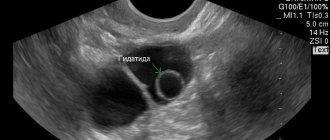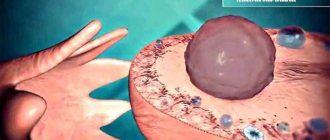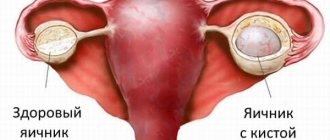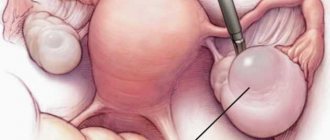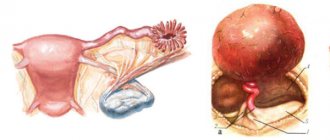A multi-chamber ovarian cyst is a benign hollow formation located on the tissues of the female reproductive gland, with viscous contents, including fluid, mucus and blood impurities. This type of tumor is considered one of the most dangerous due to the high probability of increasing in size. The most serious complications can be rupture of the cyst, degeneration into a malignant tumor, and infertility.
The ovarian cyst initially forms as a single-chamber cyst, then after the appearance of a septum in the capsule it becomes double-chambered. The number of partitions can increase, making the formation multi-chambered.
Distinctive features of the pathology are the growth of the formation to large sizes. The diameter of the cyst often exceeds 10 cm. The capsule consists of several chambers, each of which grows, contributing to the growth of the entire formation. It can be localized on each of the ovaries, or on both at once.
Multilocular cysts have the following differences:
- Pathology of the right ovary is detected more often than the left, due to the greater content of blood vessels in it.
- If left untreated for a long time, the follicular vesicles merge into one capsule.
- They have a high probability of developing complications.
- They are treated surgically and do not respond well to therapy. They don’t go away on their own.
- They have a high probability of transformation into a malignant tumor.
What is it?
Contains a large number of partitions and chambers.
Multilocular cystic formation is a compaction that occurs in the tissues of the ovary. It is a cavity containing liquid contents. It may include purulent or bloody spots.
The difference from a two-chamber cyst is that this type of thickening contains more septa and chambers. First, individual bubbles appear on the internal organ, and then unite into one large tumor.
Why is a large cyst dangerous?
Cysts up to 5 cm are considered medium. Anything higher is considered large and brings a lot of inconvenience to a woman, and can also provoke a worsening of chronic pathology and the development of other diseases. There are cysts 20 cm or more in diameter. Most often you have to deal with the following complications of such formations:
- There is compression of nearby organs - the bladder, rectum, blood vessels, and nerve endings. This leads to dysfunction, stagnation of venous blood, progression or development of varicose veins of the pelvis and lower extremities.
- Increased intra-abdominal pressure affects the diaphragm, which leads to shortness of breath and impaired cardiac function. Against the background of chronic diseases (bronchial asthma, heart defects, etc.), all this will be clearly felt by the woman.
- The larger the cyst, the higher the risk of injury and rupture, resulting in a life-threatening condition.
- Risk of malignancy and development of ovarian cancer.
Features of the pathology
A multi-chamber ovarian cyst has features that are unique to it. The main difference is the large size of the tumor. Often its diameter is more than 10 cm. The significant growth of the capsule is due to the fact that it contains several chambers at once, each of which can be large.
Features of a three-chamber (or more) cyst include:
- seals are present in the body for a long time. At first there are several bubbles and only in the absence of therapy do they merge into one capsule;
- in most cases, pathology develops on the right side, since this ovary has more blood vessels;
- degeneration into a malignant tumor often occurs precisely in connection with multilocular neoplasms;
- have a tendency to complications (twisting of the leg, rupture of the membranes, infection);
- cannot resolve spontaneously, and also respond poorly to conservative treatment methods.
Clinical manifestations of the disease
Signs of ovarian cyst formation largely depend on its histological structure and existing complications. Also, the hormonal activity of the cyst itself can have a very large influence on the clinical manifestations.
The main symptoms include:
- pain in the lower abdomen;
- disorders of the menstrual-ovarian cycle;
- pain with a certain radiation, in the rectum, in the leg, especially during cyst rupture (usually a follicular ovarian cyst ruptures);
- an increase in a woman's temperature;
- weakness and various other symptoms.
The cyst often has pronounced symptoms, usually indicating some specific complication. Therefore, it is necessary to carry out timely diagnostics, which will make it possible to implement all necessary measures in a timely manner. All symptoms can be divided into certain manifestations:
- Hormonal disorders.
- Pain syndrome.
- Intoxication syndrome.
In some cases, an ovarian cyst may not come from the ovary tissue, but from nearby tissues - this is a paraovarian cyst of the ovary. For a long period of time it shows absolutely no symptoms. For the first time, clinical signs appear only when complications occur, mainly when the cyst breaks through. Typically, these cysts are diagnosed using ultrasound. An important criterion in this case is the absence of any connection with the ovary.
Complications
It is these types of cystic formations that often cause numerous consequences. If left untreated, multilocular ovarian tumors provoke the following complications:
- twisting of the leg on which the capsule is attached. This usually occurs during increased physical activity or during sex;
- spontaneous rupture of the membranes leads to the contents entering the abdominal cavity. This causes peritonitis, sepsis, etc.;
Spontaneous rupture of the tumor causes peritonitis and sepsis.
- infection gets inside. Because of it, an inflammatory focus develops, tissue suppuration appears;
- large thickenings put pressure on other abdominal organs. This usually affects the activity of the gastrointestinal tract and bladder;
- prolonged absence of therapy leads to infertility. The proper functioning of the genital organs is disrupted, the menstrual cycle is disrupted;
Long-term lack of therapy leads to infertility.
- Benign cells often degenerate into malignant ones, which triggers the process of cancer development.
Prevention
There are factors that can provoke the formation of a multilocular cyst. Preventive measures will reduce the likelihood of its occurrence. These include the following recommendations:
- Regular visits to the doctor will allow you to diagnose pathological processes at an early stage and avoid complications.
- Barrier contraception will reduce the risk of developing infectious diseases and unwanted pregnancy, which will eliminate the need for an abortion.
- Wearing warm clothes in the cool season will eliminate the possibility of hypothermia of the genital organs and prevent inflammatory processes.
- Monitoring the regularity of your periods will allow you to notice hormonal imbalances in time.
- A healthy lifestyle will ensure a strong immune system, which reduces the risk of gynecological diseases.
Symptoms of a multilocular ovarian cyst
At an early stage, it is difficult to understand that a multi-chamber seal has formed on the ovary. As it reaches large sizes, the following symptoms appear:
Nagging pain in the side and lower abdomen.
- disruptions in the menstrual cycle (increasing or decreasing);
- nagging pain in the side where the cyst is located. They can radiate to the lower part of the abdominal cavity, to the lower back;
- bleeding or spotting between cycles;
- increase in the size of the abdominal cavity;
- weight loss may occur;
- increased body hair growth (due to increased production of male sex hormones);
- the patient cannot become pregnant.
When an inflammatory focus develops, signs of general intoxication also appear. These include fever, paroxysmal pain, nausea or vomiting, headache, etc.
Causes
When a patient contacts him, the attending physician must find out the reason that provoked the appearance of the cystic formation. It needs to be eliminated so that relapses do not occur in the future. The mechanisms of occurrence of multilocular tumors are not fully understood.
However, doctors believe that its development is provoked by the following factors:
- hormonal imbalance. Improper hormone production directly affects the process of ovulation and the menstrual cycle. If a mature follicle does not fully mature, it can cause the appearance of a cavity, which is subsequently filled with fluid;
- inflammation in the pelvic organs. Any inflammatory foci lead to a decrease in immunity and, as a consequence, to the appearance of a cyst;
- disorders during intrauterine development. In this case, the thickening will be congenital;
- surgical interventions in the pelvic organs, including those associated with artificial termination of pregnancy;
- With early menstruation or menopause, the risk of benign tumors is higher.
Why does it occur
The development of multi-chamber formation occurs in women of any age. Factors influencing the formation of the disease are different. More often these are embryonic disorders, when the cyst is a congenital pathology and is considered a developmental anomaly. This happens if during pregnancy the development of the embryo was seriously affected by external negative factors:
- tobacco products;
- alcohol;
- stress;
- use of medications;
- prolonged exposure to the sun's rays.
Also, a hereditary predisposition at the genetic level cannot be ruled out. Quite often, this pathology occurs in women who have suffered from inflammatory diseases of the genitourinary system, especially in the acute or chronic stages.
Factors of etiological origin are considered quite common causes. These include any irregularities in the menstrual cycle, such as length or regularity. Every third woman with a normal cycle, and every second woman with dysmenorrhea, is diagnosed with cystic formations.
A functional neoplasm can appear during pregnancy, as well as after surgery, such as abortion. Also, the development of pathology is influenced by the early onset of sexual activity, past or advanced sexually transmitted diseases.
Types of education
Multiseptate tumors, like other varieties, are one of the following types:
- follicular cyst. Usually this variety increases slightly in size and is treated with oral contraceptives. Appears on the ovary when the follicle has not completed the entire maturation cycle. The liquid inside the capsule contains estrogens. Cystic thickening causes disruption of the menstrual cycle, heavy bleeding at the beginning of the cycle, as well as aching pain in the abdominal cavity;
Appears when the follicle has not completed the entire maturation cycle.
- Corpus luteum cyst is a similar type of lump that develops mid-cycle. Where the corpus luteum should form, a cavity appears and fills with contents. Unpleasant symptoms appear when ovulation occurs;
- endometrioid. It occurs as a consequence of excessive growth of epithelial tissue. With this type, menstruation is heavy and painful. A woman will not be able to become pregnant until the tumor is removed;
Occurs due to excessive proliferation of epithelial tissue.
- cystadenoma. This type of benign neoplasm usually has one chamber. As it grows, thin septa form, and pain appears in the lower abdomen. Cystadenoma, according to the type of fluid contained in the cavity, can be serous, mucinous or papillary (the most dangerous type, which provokes the development of cancer cells).
Classification
Any true ovarian cysts have a tendency to form several cavities, regardless of the histological composition of their walls and contents. In this case, the partitions are formed either initially, from the moment the tumor appears, or during its growth.
Follicular cyst
It is the most common type of cystic neoplasm of the female reproductive system. It is formed from the tissues of the dominant follicle as a result of a violation of the ovulatory stage, that is, in the absence of an egg release.
Subsequently, the resulting cavity is filled with the contents of blood, lymphatic vessels or secretory fluid, which is secreted by the epithelial cells of the follicle. Despite the fact that this pathology most often turns out to be single-chamber, in the advanced stage, if left untreated, internal septa form.
Corpus luteum cyst or luteal cyst
It is a functional ovarian cyst. Appears in place of a non-regressing corpus luteum due to the accumulation of fluids that nourish it.
Paraovarian cyst
Formed from the tissues of the supraovarian appendages. Diagnosis is complicated by the fact that the neoplasm is similar in structure to the structures that form it.
Endometrioid cyst
Its walls are formed by the epithelial tissue of the ovary, and the contents become menstrual blood. It is a manifestation of endometriosis - abnormal growth of glandular tissue of the uterus.
Dermoid cyst
It refers to congenital pathologies of the female reproductive system, since its occurrence is facilitated by a violation of the intrauterine differentiation of the tissues of the embryonic germ layers of the fetus.
As the child grows, the cavity is filled with a jelly-like mass with inclusions of derivatives of the ectoderm, endoderm and mesoderm - hair, sebaceous and sweat glands, particles of skin, bones and adipose tissue.
The treatment tactics for a multi-chamber cyst are selected individually, based on its physiology and histological composition, since, unlike single-chamber cysts, they are difficult to treat without surgery.
This is explained by the fact that they are formed by several cavities at once, prone to the secretion of the corresponding fluid. Therefore, surgical intervention is considered the only sure way to prevent the development of complications.
Diagnosis and treatment methods
Typically, a woman consults her doctor when the first symptoms appear. But sometimes a neoplasm can be detected during a routine examination. By palpation, the gynecologist will determine that there is an extraneous thickening on the ovary. In the future, it will be necessary to clarify the diagnosis using modern examination methods.
By palpation, the gynecologist will determine that there is an extraneous thickening on the ovary.
The doctor will prescribe the following diagnostic procedures:
Using the device, the exact location of the capsule attachment and dimensions are determined.
- Ultrasound. Using the device, the exact location of the capsule’s attachment is determined, its dimensions are determined, as well as the number of chambers;
- if the ultrasound examination turns out to be insufficiently informative, an MRI or CT scan may be required;
- since there is a high risk of transformation of a benign tumor into a malignant one, a biopsy is required. Histological examination will determine whether cancer cells are present;
- Blood and urine tests are necessary to determine whether an inflammatory focus is present in the body. In addition, a hormonal blood test is performed;
- smears are taken to determine concomitant infections of the pelvic organs.
After receiving a complete picture of the pathology, the doctor prescribes treatment. It will depend on the type of thickening and its size, on the number of chambers, etc. At an early stage of development, a decision is often made to choose conservative treatment. In this case, hormonal drugs and anti-inflammatory drugs are used. They can be effective in cases where the tumor is small in size, there are no cancer cells, or other complications.
If the cyst does not resolve within 3 to 4 months, a decision is usually made to surgically remove it.
Therapy depending on the type
There are several types of multilocular ovarian tumors. The patient's treatment regimen is determined by a specialist, based on the tendency to malignant transformation and some other factors.
A multi-chamber retention cyst identified during an ultrasound examination requires complex therapy (puncture and surgery). This makes it possible to prevent relapse of the pathology in the future with almost 100% probability.
The follicular cyst has a functional origin. It appears at the site of an unruptured follicle and is a type of single-chamber neoplasm, but with a long existence and impressive size it can become multi-chamber. The patient is recommended to undergo continuous monitoring by a specialist for at least six months. If his recommendations are followed, the tumor usually goes away on its own. If this does not happen, then the woman is prescribed hormonal medications for at least three months. An ultrasound is then performed to analyze the effectiveness of the treatment.
A multilocular dermoid cyst usually undergoes surgical removal, since over time it can transform into a malignant neoplasm. It is characterized by the presence of fatty deposits, hairs and other foreign matter.
Treatment of multilocular endometrioid cysts is carried out both conservatively and surgically, but both methods are usually used. Before surgery, it is practiced to use hormonal agents to help reduce the size of the tumor.
Surgery
There are several types of surgery that are used in the presence of a multi-chamber capsule. The most gentle method is considered to be laparoscopy, which involves making pinpoint incisions and removing the tumor through them. But this method can only be used for small cavities.
Laparoscopy involves making pinpoint incisions and removing the tumor through them.
Classic surgical excision of tissue is used most often. During the operation, the capsule is removed along with its contents to eliminate the risk of relapse. Recovery is long and difficult. If the lump is very large, then the entire ovary may be removed along with it. This occurs in cases where the capsule interferes with its proper functioning or tissue necrosis occurs.
Danger during pregnancy
It is observed during pregnancy and removal occurs after childbirth.
It is advisable to identify and remove the cyst before planning, since it often causes miscarriages, missed abortions and other complications. Doctors avoid performing surgeries on pregnant women, as this also leads to miscarriage or developmental abnormalities in the fetus.
In most cases, they take a wait-and-see approach and monitor any changes that occur. After childbirth, removal of the multi-chamber capsule is indicated. In rare cases, when there is a direct threat to the life or health of the patient, surgical intervention during pregnancy is prescribed.
An ovarian cyst, consisting of several capsules, poses a danger to a woman at any age. Once identified, it must be immediately removed surgically. The exception is small tumors, which are tried to be cured using conservative methods.
How can it be cured without surgery?
If the cyst is small and does not bother the patient, the gynecologist may try to treat the tumor using a conservative method.
Treatment is carried out in the first few months after the formation is detected . In this case, the patient should often (1-2 times a month) visit a gynecologist for examination and perform an ultrasound examination.
Physiotherapy has a good effect on cyst resorption.
The doctor prescribes the following types of treatment:
- Balneotherapy;
- Mud therapy;
- Ultraphonophoresis;
- Magnetotherapy;
- Electrophoresis.
For drug treatment, hormonal drugs are used, depending on the existing hormonal disorders in the woman’s body .
If during treatment the cyst continues to grow and bother the patient, surgical treatment is indicated.
